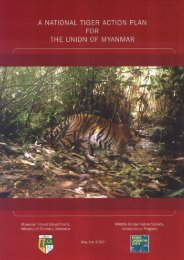Download - Global Tiger Initiative
Download - Global Tiger Initiative
Download - Global Tiger Initiative
You also want an ePaper? Increase the reach of your titles
YUMPU automatically turns print PDFs into web optimized ePapers that Google loves.
A wild Snow Leopard in its mountain habitat<br />
Credit: Fritz Pölking, courtesy of the International Snow Leopard Trust<br />
Kyrgyzstan<br />
A catastrophic decline in the number of Snow Leopards in Kyrgyzstan has been caused by a<br />
sharp upsurge in poaching and reduced numbers of wild prey animals. The population may<br />
have been reduced by 80% in the last 10-15 years (from 1200-1400 animals in the early 1990s,<br />
to 150-500 animals in the late 1990s), primarily as a result of poaching (Koshkarev, 1994).<br />
Kyrgyzstan has a history of active hunting of Snow Leopards and at one time more than 90%<br />
of Snow Leopards caught for zoos originated from Kyrgyzstan (Dexel, 2002). Hunting intensity<br />
is reported to have quadrupled at the beginning of the 1990s and to have continued at similarly<br />
high levels throughout the 1990s. Koshkarev (1994) estimated that up to 120 animals a year<br />
were being poached in the mid-1990s, mainly for the skin trade, which compares to an average<br />
of 30 Snow Leopards caught each year prior to Kyrgyzstan’s independence from the Soviet<br />
Union, in 1991 (Koshkarev and Vyrypaev, 2000). Whereas Snow Leopard skins had previously<br />
been traded for the price of a horse or five domestic sheep, in 1992/93 prices increased dramatically<br />
and a skin could be sold for around USD500-2000, which was equivalent to more than 60<br />
times the minimum annual income in Kyrgyzstan. In the winter of 1993-1994, Koshkarev<br />
observed 12 Snow Leopard skins with a single trader in the village of Kyzyl-Su and another 10<br />
skins were noted with another trader in Karakol. Traders claimed most skins were destined for<br />
the Russian Federation, China and Nepal, or for foreign visitors (Koshkarev, 1994).<br />
44 FADING FOOTPRINTS: the killing and trade of Snow Leopards

















